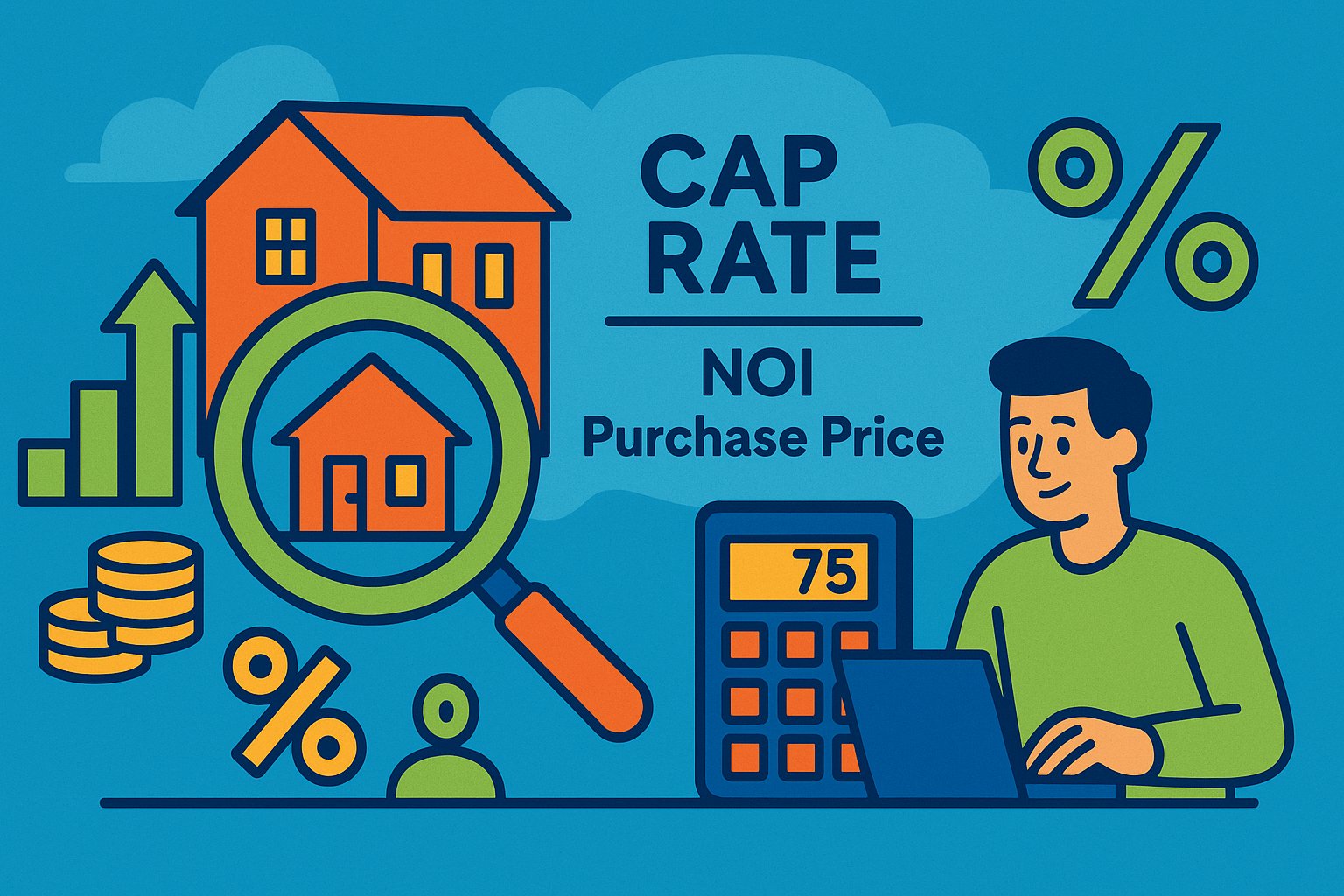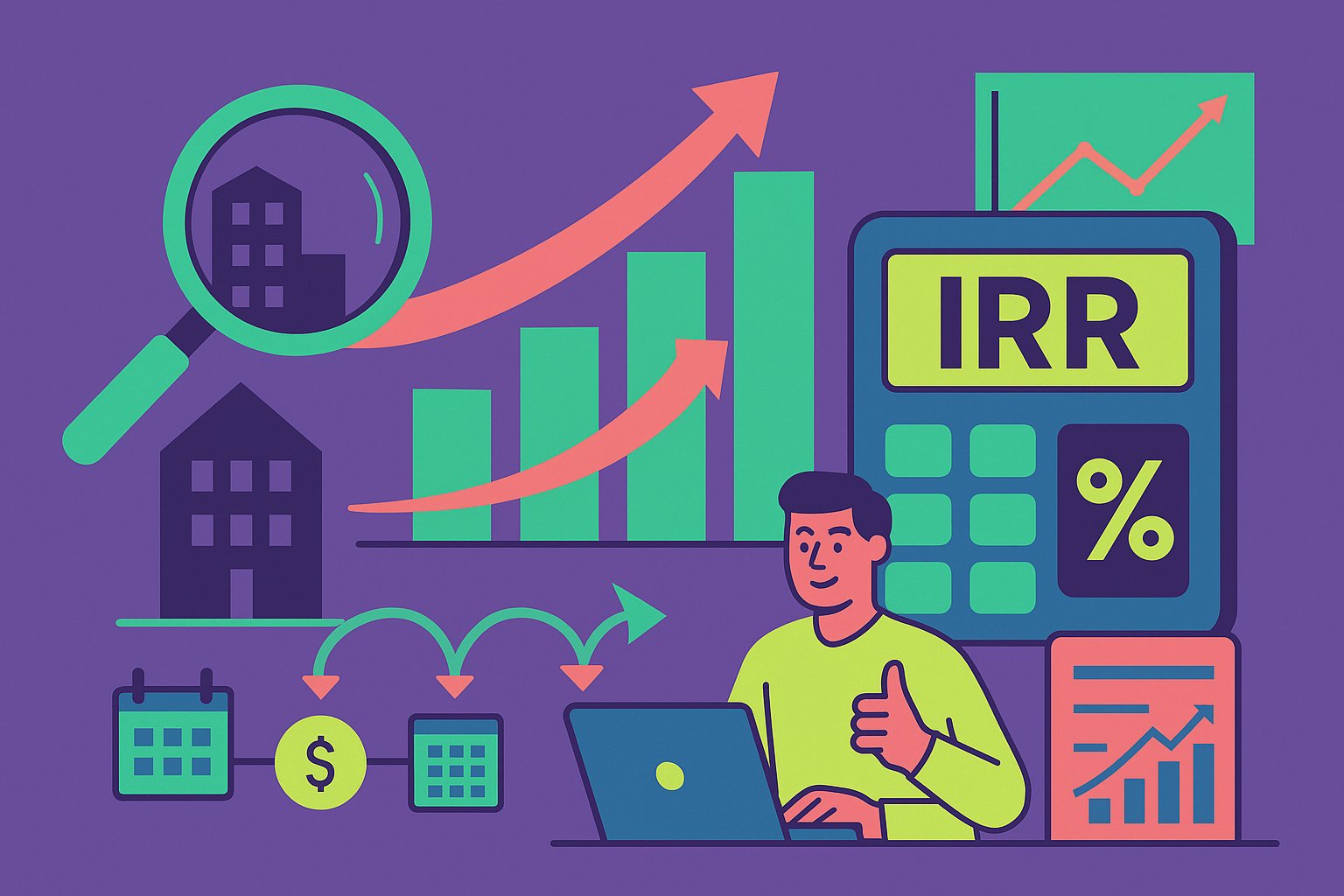Opening the Door to Cap Rates in Crowdfunded Real Estate
For many new investors, the term “cap rate” can sound technical or intimidating. Yet at its core, the capitalization rate is a straightforward ratio that reveals how much income a property generates relative to its price. In the world of real estate crowdfunding, where you’re evaluating dozens of deals online without ever touring a property in person, mastering cap rates is essential. This guide walks beginners step by step through the world of cap rates—what they mean, how to calculate them, and why they’re your best friend when comparing crowdfunded property investments. By the end, you’ll have the confidence to zero in on deals that suit your goals and separate strong opportunities from overhyped listings.
Cracking the Cap Rate Code: What It Really Represents
At its simplest, the cap rate equals a property’s Net Operating Income (NOI) divided by its purchase price (or current valuation). Imagine an apartment community that brings in $200,000 a year in rent after expenses. If that building sells for $2 million, its cap rate is 10 percent—$200,000 divided by $2,000,000. This single figure encapsulates the income yield you can expect in a stable year, assuming you buy at that price. In a crowdfunding listing, sponsors typically provide both projected NOI and price, letting you calculate or verify the cap rate yourself. Understanding this ratio gives you an immediate income benchmark—higher cap rates generally signal stronger income yields but often entail greater risk, while lower cap rates tend to indicate premium pricing and potentially more stability.
Step-by-Step: Calculating Cap Rates Yourself
Although platforms display project cap rates, doing the math on your own deepens your insight. First, gather the sponsor’s projected gross revenues—rents, parking fees, and ancillary income. Subtract all operating expenses, including property management, insurance, taxes, utilities, and reserves for maintenance, to arrive at NOI. Then divide that NOI by the property’s proposed acquisition cost or valuation. If a crowdfunding deal prices a renovated home at $500,000 and projects $35,000 in annual NOI, the cap rate is 7 percent. Calculating cap rates yourself also allows you to adjust assumptions—perhaps raising expense reserves or modeling a slower lease-up—to see how realistic the sponsor’s figures truly are before committing your capital.
Why Cap Rates Matter More in Crowdfunding Platforms
When you invest in a stock, you can check a company’s valuation multiples. In real estate crowdfunding, cap rates fill that role, serving as the universal yardstick for comparing diverse properties. Whether you’re looking at a stabilized multifamily asset in an established market or an opportunity-zone renovation project, the cap rate boils complex financials into a standardized yield measure. This consistency is crucial when platforms list properties across dozens of cities and asset classes. By scanning cap rates, you rapidly filter high-yield listings or flag deals that may be overpriced relative to their income. In other words, cap rates help you triage the deal flow, focusing your deeper due diligence on the most promising opportunities.
Market Forces and Regional Variations in Cap Rates
Cap rates aren’t uniform nationwide—local market dynamics drive them up or down. In high-growth coastal metros with soaring property values, cap rates can compress into the low 4 to 5 percent range, reflecting premium pricing and intense investor demand. Meanwhile, secondary markets with slower rent growth often trade at 8 to 10 percent cap rates, compensating investors with higher income yields. Crowdfunding platforms usually provide regional benchmarks, helping you contextualize a specific property’s cap rate against local averages. Recognizing these geographic patterns prevents you from misjudging a 7 percent cap rate: in San Francisco it might look juicy, but compared to a 3.5 percent market average, it could signal a distressed asset or weak sponsor economics.
Balancing Risk and Reward Through Cap Rate Analysis
A superficial glance at cap rates can tempt you into chasing high-yield deals, but elevated cap rates often come with elevated risks: shaky sponsorship teams, less desirable locations, or assets requiring complex renovations. Conversely, low cap rates may promise lower volatility but limit upside potential, especially if rents surge. As a beginner, your goal should be to balance risk and reward. Anchor your portfolio with a core of conservative cap rate deals in stable markets, then selectively allocate to higher-cap rate opportunities that you’ve vetted meticulously. A crowdfunding portfolio with a blend of 5 to 6 percent cap rate stabilized projects and a smaller chunk of 8 to 10 percent value-add plays can smooth out income streams while capturing additional return potential.
Peeking Behind the Numbers: NOI Assumptions and Transparency
Not all NOI calculations are created equal. Sponsors may understate expenses or overstate revenue to present an attractive cap rate. To guard against this, examine the components of the NOI line by line. Are property management fees realistic for that market? Did they include adequate reserves for tenant turnover and capital repairs? Platforms that provide detailed pro forma schedules and third-party market studies earn extra trust. As a beginner, develop the habit of poking through those line items, comparing them to public market data or independent cost estimates. The transparency of NOI assumptions can make the difference between an accurate cap rate leading to a solid investment and a misleading figure that sets you up for disappointment.
Cap Rates versus Cash-on-Cash Returns: Finding the Sweet Spot
While cap rate measures unleveraged yield, cash-on-cash return factors in financing. A property with a 6 percent cap rate financed at 70 percent Loan-to-Value (LTV) might deliver a 12 percent cash-on-cash return, thanks to leverage amplifying your equity yield. However, leverage also magnifies downside risk if cash flows dip. For crowdfunding novices, it’s wise to view cap rate as the foundation—understanding the property’s intrinsic income yield—before layering on debt considerations. Once you’ve vetted cap rates, explore how different financing scenarios affect your actual returns. This dual approach ensures you appreciate both the raw yield a property generates and the yield you pocket after financing costs.
Stress-Testing Cap Rates: Preparing for Market Swings
Markets shift, and properties rarely perform exactly as projected. To build resilience, stress-test cap rates by modeling lower NOIs or higher expenses and observing the resulting cap rate shifts. If a 7 percent cap rate property’s NOI dips by 10 percent, does the cap rate fall to 6 percent—or rise to 8 percent on a lower purchase price? Knowing how sensitive a deal is to income fluctuations helps you assess its true risk profile. Crowdfunding platforms that supply sensitivity analyses—or let you tweak assumptions in an interactive model—can be invaluable. Stress-testing prevents nasty surprises and ensures you invest in deals with enough cushion to weather economic downturns or unexpected cost overruns.
Case Study in Action: From Listing to Cap Rate Clarity
Consider an eight-unit apartment building listed on a leading crowdfunding portal. The sponsor projects $120,000 in annual NOI at a $1.5 million valuation, implying an 8 percent cap rate. You dig deeper and verify recent rent rolls through public property tax records, confirming rental income levels. You also compare insurance and management fees against similar properties in that ZIP code, validating the expense assumptions. Next, you simulate a 5 percent rent growth scenario over three years and recalculate the stabilized cap rate. By conducting this hands-on exercise, you turn a platform’s headline cap rate into a multi-dimensional insight, equipping you to decide whether that deal belongs in your portfolio.
Building Your Personal Cap Rate Framework
As you evaluate multiple listings, develop a consistent cap rate framework. Define target cap rate ranges for different deal types: stabilized core assets, light value-add renovations, and heavy redevelopment plays. Use these benchmarks to quickly filter new deals—if a property falls outside your range, it merits extra scrutiny or might be excluded altogether. Pair your cap rate framework with market research: track how local averages shift over time, adjusting your thresholds for new investments. This structured approach transforms cap rate analysis from a one-off calculation into an institutional-grade investment discipline.
Common Cap Rate Pitfalls and How to Avoid Them
Beginners often fall prey to a few recurring mistakes. First, neglecting to account for hidden expenses—like reserves for major capital improvements—can undercut the true cap rate. Second, comparing cap rates across markets without normalizing for regional differences leads to faulty conclusions. Third, assuming that a cap rate alone guarantees performance ignores the critical role of sponsorship quality and financing structure. To sidestep these traps, always review expense details, reference regional benchmarks, and overlay cap rate analysis with qualitative assessments of sponsor track record and debt terms. A comprehensive approach ensures your cap rate insights translate into successful investments.
The Evolving Role of Cap Rates in Crowdfunding’s Future
As real estate crowdfunding matures, technology is enhancing cap rate analysis. Platforms are integrating machine learning to generate real-time market cap rate maps, letting investors see yield trends at the neighborhood block level. Tokenized property interests may someday trade continuously, providing live price discovery that feeds back into updated cap rate calculations. For beginners, staying abreast of these innovations ensures you leverage the latest tools to refine your investment lens. While cap rates remain timeless in concept, the methods for analyzing and applying them are evolving—presenting exciting opportunities to gain an edge.
Your Next Steps Toward Cap Rate Mastery
Armed with this beginner’s guide, you’re poised to make cap rate analysis a cornerstone of your crowdfunding strategy. Start by recalculating cap rates on three current listings, adjusting NOI assumptions to test resilience. Compare your results against platform disclosures and regional benchmarks. Next, build your personal cap rate framework—defining target ranges for core, value-add, and opportunistic deals. Finally, integrate stress-testing and dual metrics like cash-on-cash return into your decision process. With practice, cap rates will shift from a buzzword to your most trusted filter, guiding you toward crowdfunded property investments that align with your goals and deliver sustainable returns.
By internalizing these principles, you transform complex crowdfunding listings into clear, comparable opportunities—positioning yourself to invest with confidence, discipline, and the analytical rigor of a seasoned real estate professional.




